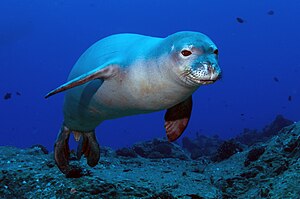Hawaiian monk seal
| Hawaiian monk seal | ||||||||||||
|---|---|---|---|---|---|---|---|---|---|---|---|---|

Hawaiian monk seal ( Neomonachus schauinslandi ) |
||||||||||||
| Systematics | ||||||||||||
|
||||||||||||
| Scientific name | ||||||||||||
| Neomonachus schauinslandi | ||||||||||||
| ( Matschie , 1905) |
The Hawaiian monk seal ( Neomonachus schauinslandi , syn .: Monachus schauinslandi ), also known as the Laysan monk seal , is an endangered monk seal species that is endemic to the tropical North Pacific near Hawaii . The scientific name refers to the German zoologist Hugo Hermann Schauinsland , who found a skull on Laysan in 1899 .
features
Hawaiian monk seals are outwardly similar to all other dog seals with their elongated body, long neck and short, wide head and short flippers (fins) . Females reach a length of 2.4 m with a maximum weight of over 270 kg, while males remain slightly smaller with a length of 2.10 m and a weight of 200 kg. They are silver to slate gray on the upper side of the body, the belly side is cream-colored. As they age, they become increasingly brownish on top and yellower on the underside. In addition, irregular spots can appear and the fur can be colored green or reddish by algae. Old males often have deep scars inflicted on them by rivals fighting over females. Young animals are born with a black, woolly coat and have a contrasting white mouth. The hair of the adult animals is very short. When the coat changes, scraps of old skin also come off. The whisker hairs on the sides of the snout are soft and dark with light tips, the whisker hair fields thick and fleshy. The Hawaiian monk seal's nostrils do not open forward, as in most other dog seals, but upward.
Habitat and way of life
The Hawaiian monk seal is endemic to the Hawaiian Islands. They are usually only up to 140 km from the nearest island. However, individual animals have already been spotted near Johnston Atoll , Palmyra Atoll and Wake Island. Hawaiian monk seals have a wide range of foods and feed on bony fish (79%), cephalopods (16%) and crustaceans (5%). Sea eels, wrasse , soldier and hussar fish , triggerfish and parrotfish are mostly caught. For resting, they prefer terraced rocky coasts or sandy and coral sand beaches that are shaded by vegetation. Outside the mating season, the animals are antisocial and live alone or females with their young. In dangerous situations the seals show their belly side, open their mouths and lift a flipper.
Reproduction
The breeding season lasts from late December to mid-August. For mating and childbirth, almost exclusively six atolls and small islands are visited which are northwest of the main islands, including the Midway Islands , the Kure Atoll , the French Frigate Shoals and the islands of Laysan and Lisianski . The males then try to get control of the stretches of beach and the females who are on them and suckle their youngsters this year and fight fierce battles among themselves. Many colonies have three times as many adult males as sexually mature females. Hawaiian monk seals mate in the water. The young are about one meter long and 16 to 18 kg in weight at birth. You will be suckled for six weeks.
Danger

The IUCN estimates the species as critically endangered and assumes a total remaining population of 600 animals. NOAA's Pacific Islands Regional Office estimated the population at 1,400 individuals in January 2017. The genetic variability of the remaining animals is very low. The main natural enemies are the tiger shark ( Galeocerdo cuvier ) and the Galapagos shark ( Carcharhinus galapagensis ).
literature
- Rüdiger Wandrey: Whales and Seals of the World . Franckh-Kosmos Verlags GmbH, 1997, ISBN 3-440-07047-6
- Hadoram Shirihai & Brett Jarett: Marine Mammals. Franckh-Kosmos Verlags GmbH, 2008, ISBN 978-3-440-11277-9
Individual evidence
- ^ GD Goodman-Lowe (1998): Diet of the Hawaiian Monk Seal (Monachus schauinslandi) from the Northwestern Hawaiian Islands during 1991 to 1994 . Marine Biology. 3 132: 535-46. PDF
- ↑ a b Neomonachus schauinslandi in the endangered Red List species the IUCN 2008. Posted by: Lowry, L. & Aguilar, A. (IUCN SSC Pinniped Specialist Group), 2008. Accessed April 5, 2012 Design.
- ^ NOAA Pacific Islands Regional Office: NOAA and Their Partners Celebrate Year of the Monk Seal , January 2017, last accessed on May 22, 2018.
- ↑ J. Schultz, J. Baker, R. Toonen, B. Bowen (2011): Range-Wide Genetic Connectivity of the Hawaiian Monk Seal and Implications for Translocation . Conservation Biology. 1 25: 124-132. doi : 10.1111 / j.1523-1739.2010.01615.x
- ↑ P. Bertilsson-Friedman (2006): Distribution and Frequencies of Shark-inflicted Injuries to the Endangered Hawaiian Monk Seal (Monachus Schauinslandi) . Journal of Zoology 268 (4): 361-68. doi : 10.1111 / j.1469-7998.2006.00066.x